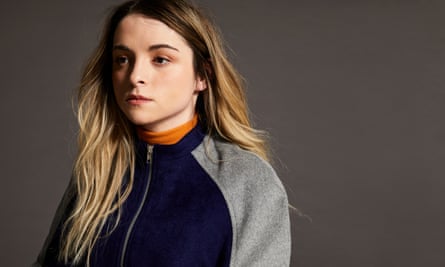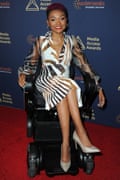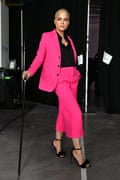Beyond greige orthopaedic footwear and sweatpants – a cardinal sin according to the late Karl Lagerfeld – your options as a trend-seeking disabled shopper have been slim pickings. In a land where “figure hugging” is a powerchair poncho, it seems sartorial rules need not apply.
However, the last year has seen a radical rethink in our understanding of how to design for disability. The rise in adaptive fashion – clothing specifically designed for those with disabilities and chronic conditions – reflects newfound awareness of inclusive design. In fact, searches for adaptive clothing saw an increase of 80% over 2019, according to global fashion search platform Lyst. This encompasses everything from discrete elasticated waistbands, which are pinch-free when seated, to magnetic fastenings for independent dressing. All aspects of the garment are fabricated with the wearer’s everyday challenges in mind. So, for many of the UK’s 13.9 million disabled people, it is welcome progress.
The pioneers of adaptive fashion
As the first mainstream brand to launch an adaptive fashion line, Tommy Hilfiger has illustrated – with aplomb – the power of creating stylish clothing for consumers who have been historically overlooked. Unveiled at New York fashion week in September, the latest Tommy Hilfiger X Zendaya collection features 10 adaptive styles. Think 70s-style metallic gold turtleneck with hidden zipper and houndstooth blazer featuring magnetic closures.
Likewise, earlier this year Nike launched their Air Zoom Pegasus 35 FlyEase trainers in the UK – a model with revolutionary adaptive technology. A wraparound zip at the back of the shoe connects to cables that tighten the laces – allowing the wearer to put on the shoe with one hand. With the 2020 Paralympics on the horizon, Nike recently announced a new partnership with Handsfree Labs Inc, a pioneer in hands-free footwear technology. This whole endeavour was sparked by a letter from an American student with cerebral palsy sharing his dream of tying shoe laces independently.
Consumer demand was also the catalyst for Seasalt’s Easy On line, which launched in March after customers of the Cornish-lifestyle brand requested inclusive options. The adaptive collection features sleeve loops to help pull garments on, large zip-pulls and magnetic fastenings on their popular styles.
New start-ups offering disability-friendly fashion

In February, a Manchester-based start-up Kintsugi joined the adaptive fashion market. Its name draws on the Japanese art form of repairing broken pottery with gold lacquer—reflecting the brand’s philosophy that all individualism is beautiful. The founder Emma McClelland believes we cannot underestimate the importance of chic yet accessible clothes: “The brand is about empowerment – it’s a middle finger to the fashion industry’s reluctance to represent people who fall outside its narrow limits.”
This idea of design bias is also the driving force of FFORA, a new accessory line for wheelchair users. Since July, FFORA has launched leather bags, lifestyle products and minimalist attachments for mobility aids. Created by Welsh-born Lucy Jones, whose thesis collection for disabled people landed her on the Forbes 30 Under 30 list – it is a masterclass in modern, inclusive fashion.

Likewise, a new London-based lingerie brand Elba – “Able” spelt backwards – focuses on front-fastening bras for individuals with limited mobility or difficulty dressing. Their patented magnetic closure is concealed at the front to balance the need for functionality with sleek styling.
Designing for disability
This year, ongoing conversations about diversity in fashion have provoked questions such as: how can brands better cater to all minority groups? But when it comes to designing for a wide range of disabilities, this simple question is still considered a Herculean task. The design process is multifaceted and often demands medical input.
According to Stephanie Thomas, disability stylist and founder of Cur8able, there are three vital requirements – a garment must be accessible when dressing, medically safe, and all-importantly look fashionable. Ten years in the making, her trademarked Disability Fashion Styling System has become the definitive guide for adaptive fashion design. “As a woman with a disability I want to shop brands that are in line with my aesthetic … I like adaptive clothing that’s beautifully designed with disability in mind.”
A financially lucrative market

Photograph: Craig Barritt/Getty Images for TIME 100 Health Summit
For many forward-thinking brands, offering inclusive fashion is not just a moral decision. It is based on the knowledge that disabled shoppers represent £249bn of spending power. Known as the “purple pound”, they remain the largest untapped consumer market. This year, Coresight Research even estimated the adaptive clothing market will reach $288.7bn globally in 2019. But, more than ever, consumers want to align themselves with brands that make a positive impact. Whether it is sustainability or inclusivity, social consciousness is the hottest trend right now.
What’s next for adaptive fashion?
In the last year, activists such as Selma Blair and Sinéad Burke have proved that disability and style are not mutually exclusive. But the high street does not yet reflect this shift. Unlike the US, where a handful of mainstream stores have adaptive lines, UK retailers remain slow to enter the market. Designers must also address the unmet demand for disability-friendly workwear and occasionwear –because even sport-luxe sweatpants can’t take you everywhere.
